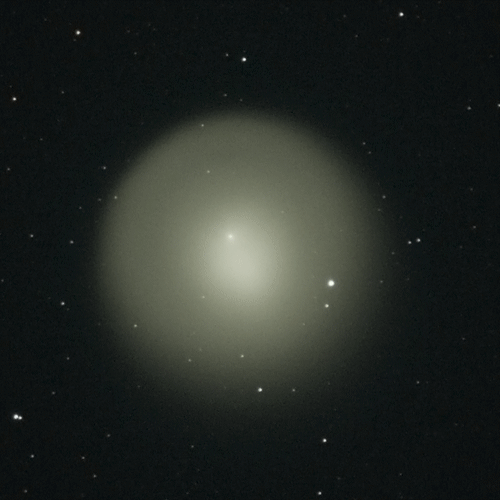A GIF animation of the comet's movement during 85 minutes, one 20-second exposure every 5 minutes. File size 2.1 MB, so it may take a while to load. The autoguider was trained on a star. North is up, east to the left.
If the animation does not run smoothly in your web browser, you can save it to your harddisk and view it from there.

This comet was good for a great surprise in October 2007: Normally 17P/Holmes is a faint object for larger amateur telescopes, at an apparent brightness of about 17 mag, being located in an orbit somewhere between Mars and Jupiter, far from sun or earth. But on October 24th it featured a spectacular brightening - by nearly a million times, shining at mag 2.5! During the rest of October and until November is remained a naked-eye target, but it brightness slowly dwindled, while its size increased. 17P/Holmes appeared as the third brightest "star" in the constellation Perseus during its brightness peak (actually it was apparent as tiny disk even to the naked eye). By the end of November, it was larger in apparent diameter than the moon. Actually, it is currently the largest body in the solar system (although not a massive one - just dust and gas).
Its visual appearance in telescopes was quite unusual for a comet: Only the nearly circular coma was visible, but no tail. Within the coma a false nucleus (slightly brighter than a star) was discernable somewhat off-center. A faint tail is only observable in deep photographs, and it appears short and frayed. Since the tail was pointing nearly away from earth into space, we were looking down its length. The comet was nearly on the opposite side of Earth from the Sun, so we were looking at it face-on.
The color of the inner coma was slightly yellow, which was caused by dust reflecting sunlight, as confirmed by spectra. The faint outer coma appeared green or turquoise - typical for ionized gas.
Comet 17P/Holmes was discovered by Edwin Holmes on November 6, 1892, while he was conducting regular observations of the Andromeda Galaxy (M31). Its discovery was made because of an outburst in brightness similar to the 2007 outburst.
The physical reason for the sudden outburst is still unknown. It might be a collision, a new fissure developing in the surface of the nucleus, or even a break-up of the whole comet, which sets free this large amount of dust and gas which we can observe because it is reflecting sunlight.
Exposure Data